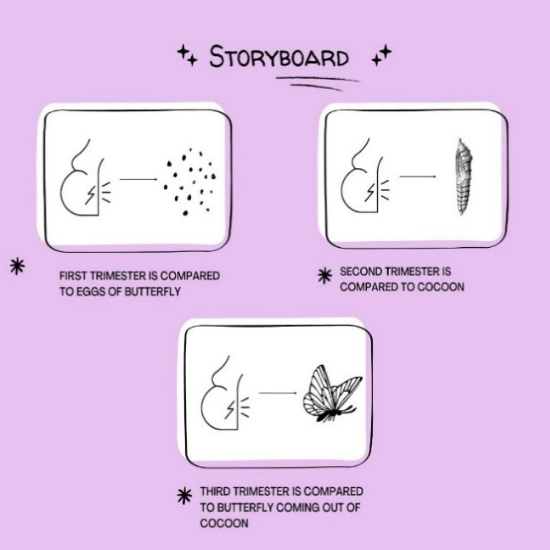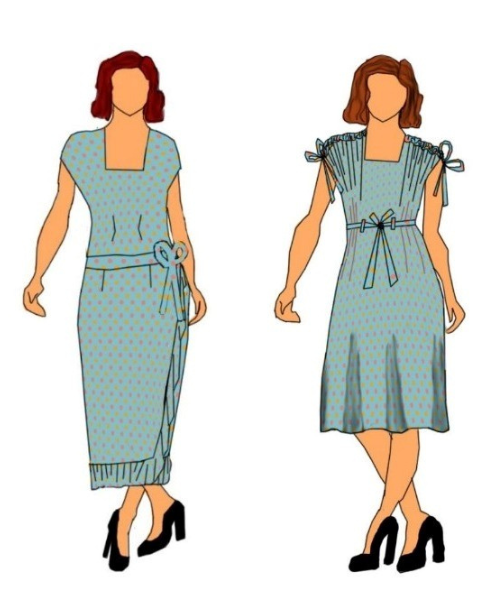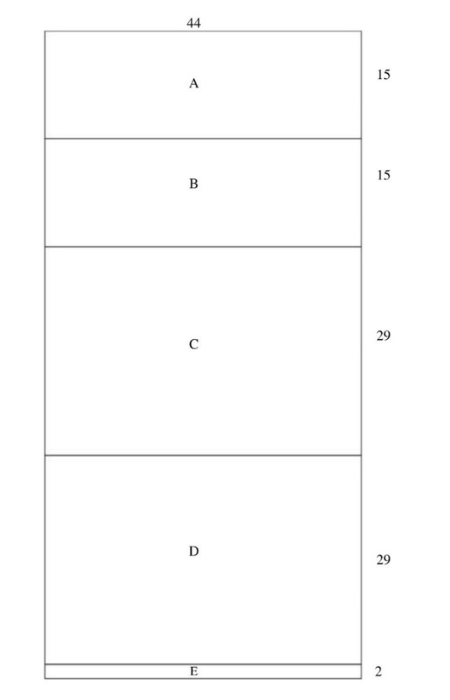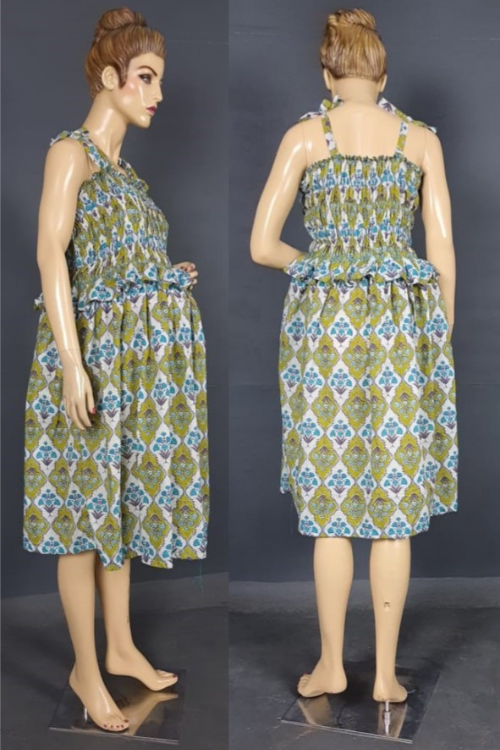Volume 01, Issue 01, Pages 30-40
Website: https://glim.vyomhansjournals.com
Sustainable Zero Waste Pattern Making: Geo-Cut Techniques for Pre and Post-Maternity Wear Design
1, 2 Department of Apparel & Fashion Design, PSG College of Technology,
Coimbatore-641004, Tamilnadu, Bharat (India).

ARTICLE INFORMATION
Vol. 01, No. 01(2024); pp 30-40
| Received | : 02-07-2024 |
| Accepted | : 26-10-2024 |
| Published Online | : 11-11-2024 |
Identifier-ARK:
ark:/85846/glim.2025AR.0101030
Copyright & License:
©2024 B. Netra and Subathra B. This is an Open Access article published in "Journal of Green Lifestyle and International Market" (GLIM) a Platinum Open Access Journal published by Vyom Hans Publications, Bharat (India). Article published with a Creative Commons Attribution-CC-BY4.0 International License. This license permits unrestricted use, distribution, and reproduction in any medium, provided the original author and source are credited.
Background: Zero-waste pattern making is an innovative approach to garment design that minimizes fabric waste and aligns with sustainable
fashion goals. The technique involves creating patterns that use the entire fabric, reducing environmental impact by eliminating scraps.
This approach is especially important in maternity wear, where
comfort, adaptability, and environmental responsibility are priorities.
Purpose: The aim of this study is to design and develop pre- and
post-maternity wear using a zero-waste pattern-making approach,
with a focus on the geo-cut technique. The objective is to create
garments that adapt to the changing body shape during pregnancy,
ensuring both functionality and sustainability while addressing the
unique needs of each trimester.
Methods:The geo-cut technique was used to design maternity wear
that adapts to size variations throughout and after pregnancy. The
study included creating multi-view drawings in CAD to facilitate
just-in-time delivery and ensure consistent documentation for each
design. A soft, sustainable cotton fabric was selected, and the
garments were tested for comfort and adaptability across trimesters,
along with an assessment of the impact of zero-waste patterning on
production efficiency.
Results:Garments developed using the geo-cut zero-waste technique
demonstrated high adaptability and comfort across all trimesters.
Initial feedback indicates strong client acceptance, with the designs
being both aesthetically pleasing and cost-effective due to reduced
fabric waste. The application of zero-waste patterning successfully
aligned with sustainability objectives while maintaining product
appeal.
Conclusions: The use of zero-waste pattern-making in maternity
wear design, particularly through the geo-cut technique, has proven
effective in addressing both environmental concerns and customers’
needs for adaptable clothing. This approach underscores the potential
for wider adoption of zero-waste techniques within sustainable fashion.
Keywords: Geo-cut technique, Maternity wear, Sustainable fashion,
Zero-waste pattern making.
Introduction
Pregnancy is a unique and unforgettable experience for a woman. Women
during pregnancy have a larger demand for clothing in terms of comfort,
security, and attractiveness due to their powerful hormone production
and special requirements for psychology, physiology, and physical
characteristics [1].
Sustainability entails safeguarding the environment and ensuring fair
working conditions in the sector while still allowing the industry to
function. It’s a broad phrase that encompasses topics like climate,
consumption, and local environment improvement. The goal of sustainable
development in the fashion business is to benefit everyone involved in
the supply chain. Because many people and families rely on the labor
that comes with it, it has a major impact on communities all over the
world [2].
As customers, we have the option of purchasing goods created in
environments where workers are treated fairly. As a result,
sustainability entails not just conserving the environment, but also
safeguarding the people who work in the business and ensuring that the
industry benefits the community where it is produced. Sustainability
isn’t just a passing trend in the apparel industry; it’s a long-term
trend that might last several seasons [3].–[4].
Environmentally conscious fashion designers are reinstating ecologically
good practices like using environmentally friendly materials and using a
socially responsible manufacturing procedure. In current society,
unethical clothing consumption is considered as an urgent issue,
particularly in light of the rise of fast fashion [5]. The apparel industry has changed dramatically in
recent years, with considerable product price deflation to satisfy
consumers’ desire for fashionable items at a low cost. The main problem
with the apparel industry is sweatshop sourcing, which consistently
violates pay agreements, basic human rights, and a slew of health,
safety, and environmental rules [6].
The term ’zero waste’ has arisen as the new savior for combating textile
contamination, which is the world’s second-largest source of waste. Of
the created waste roughly two-thirds of the textiles produced end up in
landfills from the design process to production and final use [7]. Understanding these processes
will aid in the elimination of waste-producing activities during the
design stage, saving a major percentage of textiles from becoming
unusable garbage [8].
It’s critical to include this sustainable approach to clothing in all
aspects of garment design, therefore in this article, zero-waste
sustainability is applied to maternity apparel.
Review of literature
Pregnancy
For a woman, pregnancy is a once-in-a-lifetime experience. Due to their powerful hormone production and particular requirements for psychology, physiology, and physical characteristics, pregnant women have a higher demand for clothing in terms of comfort, security, and attractiveness [9].
Maternity clothes
Today, maternity wear places high expectations on the materials used in terms of comfort and functionality. Expecting mothers prioritize materials that are good for their skin or that do not emit radiation. Pregnancy clothing requires a certain amount of flexibility and ductility; therefore, the first choice should be a fabric with superior elasticity. Additionally, we should avoid utilizing materials that cause pressure on expectant mothers and hurt their ability to breathe and circulate blood. To prevent pushing on the vessels and developing varicose veins, the sleeve cuff and bottom of the trouser leg should be designed with enough room for relaxation [10]–[11]–[12].
Physical and Psychological physical discomfort during pregnancy
Women experience a variety of discomforts throughout pregnancy. On a
mental level, they have a lot of mood swings and even depression. They
sweat profusely and experience discomfort as they urinate more
frequently than normal. Due to hormonal imbalance, mood swings play a
significant role throughout pregnancy. Some aspects of clothing design
can help with this. Mood is frequently considered to be a psychological
response to outside stimuli as a state of mind or feeling. Recent
scientific findings define the average mood as being bio-psychological
and serving as the general gauge of both physiological functioning and
psychological experiences. Contrary to acute emotions like fear or
surprise, moods can be divided into two categories: positive and
negative, or being in a good mood (happy) or a poor mood (sad). Similar
to a clinical thermometer, the mood is fluctuating and reflects all of
the internal and external factors that have an impact on us. The
underlying psychological causes and effects of mood are currently being
studied due to complexity and resource constraints. However, on a
conscious level, we can distinguish mood from fundamental physiological
consequences and psychological sensations [13]–[14].


Pregnant women have distinct physical, psychological, and physiological needs during each trimester. In the first trimester, the body begins adapting to the pregnancy, but physical changes aren’t as visible. Women often experience fatigue, mood swings, and emotional stress. Clothing needs to focus on comfort, light fabric, and stress-relieving colors to help manage these early symptoms [15]–[16]. In the second trimester, the baby bump becomes more prominent, so there’s a need for flexible clothing that accommodates a growing abdomen while offering support and comfort. At this stage, the design also benefits from features that can support breastfeeding for post-pregnancy use. By the third trimester, physical discomfort, anxiety, and fatigue are heightened, necessitating ergonomic designs that provide more room, especially around the belly, and use calming, mood-enhancing colors.
Material selection for maternity wear
Early pregnancy is a key time for a fetus’ heart, lungs, and liver to develop, and radiation can harm these organs. As a result, scientists and engineers have been attempting to create and improve radiation-resistant fabrics. Mixed metal fiber, which accounts for 30 percent of the total in the early radiation suit, is the most important component. Silver fiber fabric with antibacterial and skin-protective qualities became available later. Natural silk protein contains 18 distinct amino acids that are good for your health by smoothing your skin, nourishing your body and heart, and lowering stress so you can sleep better. Furthermore, a unique mixed fabric with a pleasant touch and light texture that is safe to wear may be created by blending silk and silver fiber in a certain proportion [17]–[18].
Ergonomic study of maternity wear
The majority of pregnant women have a chest circumference of 90cm to 96cm, accounting for 35 percent of all cases. From this point on, the frequency gradually decreases. When it comes to waist circumference, the 89-93 cm range has the largest distribution, accounting for 22 percent of the total. Furthermore, the distribution of mid-hip circumference is concentrated in the 101-105cm area, which accounts for 20 percent of the total, whereas the distribution of hip circumference is concentrated in the 101-105cm sector, which accounts for 18 percent of the total. During pregnancy, the size distribution of the four major body components is more dispersed than usual [11].
Designing maternity wear
Zero waste garments
The term ’zero waste’ has arisen as the new savior for combating textile contamination, which is the world’s second-largest source of waste [7]. Of the created waste roughly two-thirds of the textiles produced end up in landfills from the design process to production and final use. Understanding these processes will aid in the elimination of waste-producing activities during the design stage, saving a major percentage of textiles from becoming unusable garbage [19]–[20]–[21].



Zero waste fashion techniques
To achieve zero-waste fashion design, there are a few options:
Planned Chaos
Geo Cut
Cut and Drape
Reusing scraps of cloth and yarn
Jigsaw puzzle
Subtraction cutting
Geo cutting
The geo-cut technique is a zero-waste method that involves using geometrical shapes like squares and triangles in pattern design. This approach has roots in historical garments like kimonos and the Indian dhoti, which use rectangular or uncut fabric. In the context of zero-waste fashion, geo-cutting is significant because it allows designers to minimize waste by utilizing the entire fabric, eliminating the need to discard excess material. This method is especially relevant for maternity wear because it accommodates body changes by using flexible shapes that can adapt to various body sizes and shapes, offering long-term use and minimizing environmental impact [22].
Theme and Story Boards
The theme board Figure 1 has been designed to compare butterflies with pregnancy. The zero-waste geo-cut technique is used to design maternity wear, which is innovative for a few reasons. Traditional maternity wear often does not prioritize sustainability, leading to fabric waste and environmentally harmful practices. By applying zero-waste principles, this research reduces textile waste from the design and production process, making it an environmentally friendly choice [23]–[24]. In the storyboard, Figure 2, the designs are inspired by the butterfly life cycle, symbolizing the growth and transformation during pregnancy. Each trimester’s garment is designed with specific cuts, colors, and flexibility features that align with the unique needs of that trimester, offering psychological comfort and practicality for mothers.
Methodology
Design inspiration
The butterfly life cycle serves as a metaphor for the transformation during pregnancy. The three different stages are shown in figures-1,2 and 3.
First Trimester-Eggs:
In this early stage of pregnancy, the garment is simple and understated, reflecting the early stage of development. The kaftan dress, Fig. 6-7, with a relaxed fit and calming polka-dot patterns, provides comfort and aligns with the psychological changes that occur in the first trimester.


E- Waist Belt; F- Belt Loop; G- Shoulder String; Pattern 2: Style 2- Kaftan Dress

& Left; C-1st And 2nd Tire; D-3rd Tire

F-Collar; G-Bow; H-Skirt Part; Pattern 4: Style 1- V-Neck Pleated Dress

C- Front Skirt; D- Back Skirt; E- Shoulder Strap

Pattern 6: Style 2- Full Length Kaftan
Second Trimester-Cocoon:
This stage represents a time of growth and transformation. The tiered dress with pleats and gathers around the waist mirrors, Fig. 8-9, the cocoon stage of a butterfly’s development. This dress incorporates a zipper for easy breastfeeding access, making it useful post-pregnancy as well.
Third Trimester-Butterfly:
This stage symbolizes the butterfly emerging from its cocoon, fully developed. The shirred dress, Fig. 10-11, with frills at the waist and vivid, yet calming colors represents this transformation. The design offers extra space for comfort and ease, reflecting the final stages of pregnancy when the mother and baby prepare for birth.

Result and Discussion
Construction of Garments
Kaftan Dress
As shown in Figures 12-13 A&B, first-trimester garments are designed and constructed with zero waste geo-cut technique. This design has a tie cord in the shoulder and waist for a better fit. It is a free-size garment that anyone can wear at any time, as there will be not much projection in bump. Here the fabric is pure cotton and the print will be polka dots. The first trimester is compared with butterfly eggs i.e. the formation of the baby and slight development of the baby with not much physical pressure. But mentally they go through some stress and the colors of the pattern are designed based on this, so that they will be relaxed.

Tiered Dress


As shown in Fig 14-15 (A&B), the second-trimester garments are designed and constructed with zero waste geo-cut technique. This design is a three-toned dress with pleats on the shoulder and gathers at the waist. This garment has a zipper for feeding, which can also add aesthetic value. The second trimester is compared with the cocoon where the butterfly is developed. During this trimester the baby will be fully formed and will be grown to form the belly bump. Here the pattern was inspired from the cocoon and designed with bright colors that enhance their mood.
Shirred Dress


As shown in Fig 16-17 (A&B), the clothing for the third trimester is developed and made using a zero-waste geo-cut technology. A shirred dress with frills at the waist is included in this design. It also features a feeding zipper in the waist. The third trimester is likened to a butterfly emerging from its cocoon with wings and colors. The kid will be fully formed at this point, and the delivery will take place. Pregnant ladies will experience a great deal of anxiety and despair. To lighten them up, a butterfly motif with vivid yet tranquil colors is given.
Costing
Garment 1:
Fabric required: 2.625 meters
Cost of the fabric per meter in Rs. 120/-
| Item | Price (Rs.) |
|---|---|
| Cost of the required fabric | 315 |
| Cost of zipper | 10 |
| Stitching charge | 300 |
| Profit (10%) | 63 |
| Total cost | 688 |
Garment 2:
Fabric required: 3.325 meters
Cost of the fabric per meter in Rs. 120/-
| Item | Price(Rs.) |
|---|---|
| Cost of the required fabric | 400 |
| Cost of zipper | 10 |
| Stitching charge | 350 |
| Profit (20%) | 152 |
| Total cost | 912 |
Garment 3:
Fabric required: 2.25 meters
Cost of the fabric per meter in Rs. 120/-
| Item | Price(Rs.) |
|---|---|
| Cost of the required fabric | 270 |
| Cost of zipper | 50 |
| Stitching charge | 300 |
| Profit (20%) | 124 |
| Total cost | 744 |
As a result, zero waste of maternity wear for each trimester is achieved. Through the costing of the garment, it is observed that these zero-waste maternity dresses are much more affordable.
Conclusion
Balancing our demands without compromising future generations’ ability to solve their challenges is what sustainability entails. We don’t just need physical assets; we also need social and financial assets. Sustainability isn’t simply environmentalism. Inserted in many meanings of sustainability we additionally track down worries for social value and monetary turn of events While the idea of sustainability is a generally groundbreaking thought, the development overall has established in civil rights, traditionalism, internationalism, and other past developments with rich accounts. Before the finish of the 20th hundreds of years, a significant number of these thoughts had met up in the call for a ’feasible turn of events.
Garments are designed by analyzing the challenges that pregnant women confront during each trimester. The baby’s growth is compared to the butterfly life cycle, and each trimester is designed accordingly. Even after the baby is born, the outfits from the second and third trimesters can be worn. Nursing facilities are available in the second and third trimesters. Colors and styles have been chosen to make them more comfy.
Here with sustainability, the zero waste geo-cut technique is implemented. The patterns are made with no fabric wastage for all six garments and one from each trimester is stitched and costing is done. With costing it is clear that the zero waste maternity wear can be affordable.
Authorship contribution
The first Author B. Netra, did analysis and produced the product. Mrs. Subathra B, guided her throughout design work and prepared manuscript for publication and communication and corrections were done.
Funding
No funding was taken for conducting this research.
Conflict of interest
The authors state that there is no conflict of interest.
Similarity Index
I hereby confirm that there is 6% of plagiarism achieved in paper where individual source contribution is 1% or less than 1.
Data availability statement
Data sharing is not applicable to this article as no data set were generated or analyzed during the current study.
Declaration
This research has been conducted ethically, reporting of those
involved in this article. The selection of product, collection of raw
materials, end product samples, all the other works are specifically
done by the authors. The photographs were not taken from any sources.
These are the original photographs taken by the investigator
specifically for the work, not taken from any other social media
platforms.
References
- Sarkar, J., & Rasel, S. (2017). Maternity clothing: A comprehensive review. Textile Focus. Retrieved from http://textilefocus.com/maternity-clothing-comprehensive-review/ .
-
Shen, B. (2014). Sustainable fashion supply chain: Lessons from H&M. Sustainability, 6(9), 6236-6249.
https://doi.org/10.3390/su6096236 .
- Caniato, F., Caridi, M., Crippa, L., & Moretto, A. (2011). Environmental sustainability in fashion supply chains: An exploratory case-based research. International Journal of Production Economics, 135(2), 659-670. https://doi.org/10.1016/j.ijpe.2011.06.001.
- Gupta, L., & Saini, H. K. (2020). Achieving sustainability through zero waste fashion: A review. Current World Environment, 15(2), 154-162. http://dx.doi.org/10.12944/CWE.15.2.02.
- Centobelli, P., Abbate, S., Nadeem, S. P., & Garza-Reyes, J. A. (2022). Slowing the fast fashion industry: An all-round perspective. Current Opinion in Green and Sustainable Chemistry, 38, 100684. https://doi.org/10.1016/j.cogsc.2022.100684.
- Burdett, K., & Mortensen, D. T. (1998). Wage differentials, employer size, and unemployment. International Economic Review, 39(2), 257–273. https://doi.org/10.2307/2527292.
- ElShishtawy, N., Sinha, P., & Bennell, J. A. (2021). A comparative review of zero-waste fashion design thinking and operational research on cutting and packing optimisation. International Journal of Fashion Design, Technology and Education, 15(2), 187–199. https://doi.org/10.1080/17543266.2021.1990416.
- Gupta, R., Kushwaha, A., Dave, D., & Mahanta, N. R. (2022). Waste management in fashion and textile industry: Recent advances and trends, life-cycle assessment, and circular economy. In C. M. Hussain, S. Singh, & L. Goswami (Eds.), Emerging trends to approaching zero waste (pp. 215–242). Elsevier. https://doi.org/10.1016/B978-0-323-85403-0.00004-9.
- Fredrickson, B. L. (2001). The role of positive emotions in positive psychology: The broaden-and-build theory of positive emotions. American Psychologist, 56(3), 218-226. https://doi.org/10.1037/0003-066X.56.3.218.
- Sohn, M., & Bye, E. (2015). Pregnancy and Body Image: Analysis of Clothing Functions of Maternity Wear. Clothing and Textiles Research Journal, 33(1), 64-78. https://doi.org/10.1177/0887302X14557809.
- Shang, Y., & Hu, X. (2015). Ergonomic maternity dress design. Procedia Manufacturing, 3, 187-191. https://doi.org/10.1016/j.promfg.2015.07.127.
- Sen Kılıc, A., Tama, D., & Ondogan, Z. (2014). Clothing problems with maternity garments. XIIIth International Izmir Textile and Apparel Symposium. Retrieved from https://textile.egetr.edu.tr.
- Sekhon S, Gupta V. Mood Disorder. [Updated 2023 May 8]. In: StatPearls [Internet]. Treasure Island (FL): StatPearls Publishing; 2024 Jan-. Available from: https://www.ncbi.nlm.nih.gov/books/NBK558911/.
- Kirsh, D. (2023). Atmosphere, mood, and scientific explanation. Frontiers in Computer Science, 5:1154737. https://doi.org/10.3389/fcomp.2023.1154737.
- Kaur, A. (2020). A link between colors and emotions: A study of undergraduate females. International Journal of Engineering Research & Technology, 9(9), 553-557. https://doi.org/10.17577/IJERTV9IS090319.
- Yang, D. (2017). Color design and implementation of smart mood-changing clothing. International Conference on Technology and Business Management, ISBN: 978-1-943295-06-7, 70-73. Retrieved from https://www.ictbm.org/ictbm17/ictbm17cd/pdf/T135-final.pdf.
- Shamsaei, A., Kazemi, A., Enteshary-Najafabadi, H., & Borujeni, N. K. (2022). Essential criteria for designing healthy maternity wear: A narrative review. Iranian Journal of Nursing and Midwifery Research, 27(6), 492–495. https://doi.org/10.4103/ijnmr.ijnmr_143_22.
- Fatahian, R. et. al.,(2021) A critical review on application of silk sericin and its mechanical properties in various industries. Journal of Research and Applications in Mechanical Engineering (JRAME), 9(2),1-11. https://doi.org/10.14456/jrame.2021.19.
- Pinkie, M., Hasnine, S., & Rahman, I. (2019). An experiment to create zero-wash clothing by stitching and slashing technique. International Journal of Scientific & Engineering Research. Retrieved from https://www.ijser.org. https://doi.org/10.14299/ijser.2019.10.06.
- Rissanen, T. (2013). Zero waste fashion design: A study at the intersection of cloth, fashion design and pattern cutting (Doctoral dissertation). Retrieved from https://opus.lib.uts.edu.au/handle/10453/23384.
- McQuillan, H. (2019). Hybrid zero waste design practices. Zero waste pattern cutting for composite garment weaving and its implications, The Design Journal, 22(sup1), 803-819. https://doi.org/10.1080/14606925.2019.1613098.
- Sawhney, M. K. (2023). Zero waste fashion: Exploring zero-waste pattern cutting to eliminate fabric waste in the garment manufacturing industry. Trends in Textile & Fashion Design, 6(1), 981-987. https://doi.org/10.32474/LTTFD.2023.06.000226.
- Rahaman, M. T., Pranta, A. D., Repon, M. R., Ahmed, M. S., & Islam, T. (2024). Green production and consumption of textiles and apparel: Importance, fabrication, challenges and future prospects. Journal of Open Innovation: Technology, Market, and Complexity, 10(2), 100280. https://doi.org/10.1016/j.joitmc.2024.100280.
- Lei, G., & Li, X. (2021). A Pattern Making Approach to Improving Zero-Waste Fashion Design. Fashion Practice, 13(3), 443–463. https://doi.org/10.1080/17569370.2021.1982503.
How to Cite?
B. Netra, & Subathra B (2024). Scoping Review of Pressure Ulcer Prevalence and Prevention in Elderly Inpatient Care in England. Journal of Green Lifestyle and International Market-(GLIM), 1(01), 30-40. Retrieved from https://glim.vyomhansjournals.com/index.php/fashion/article/view/
Corresponding author: bsa.afd@psgtech.ac.in↩︎